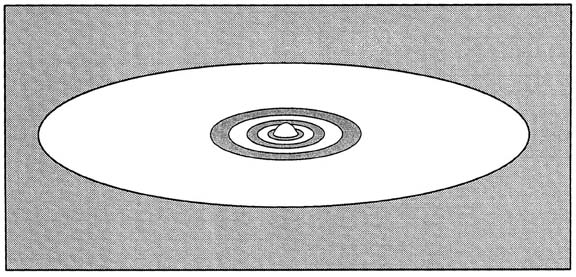The story of Atlantis related in Plato’s Timaeus dialogue refers to catastrophic flood events which actually took place at the end of the last ice age. In fact, the date ~9,600 B.C. marks the time of the sudden transition from cold to warm climate, a period accompanied by catastrophic floods of glacial meltwater and subsidence of the ice sheet into the Atlantic. Parallels between the Timeaus account and actual ice age events are explored in the book Earth Under Fire.
However, an entirely different symbolic meaning of Atlantis is encountered in the story given in Plato’s Critias dialogue which focuses on describing the creation of Atlantis, prior to the Atlantian flood myth. As we shall discover here, this part of the Atlantis story conceals an extremely advanced scientific knowledge of how matter comes into being in the universe. In the early 80’s, LaViolette had proposed that subatomic particles are field wave patterns (ether concentration patterns) that emerge spontaneously in a reacting and diffusion ether whose constituent reactions may be represented by a Brusselator-like reaction-diffusion system called Model G. He later realized that when these subatomic field patterns are charted in two dimensions, they appear very similar to the image of Plato’s Atlantis shown below. LaViolette explores this in his book Genesis of the Cosmos, where he proposes that Atlantis was intended as a symbolic representation of the electric field that forms the structure of a subatomic particle.
The illustration shown below is a map of Atlantis based on the measurements given in Critias. White areas indicate land and grey areas indicate water.

Atlantis mapped to the dimensions specified in Plato’s myth.
Some years later, in 2002, particle scattering data from the Jefferson Laboratory in Virginia demonstrated that the electric field in the nucleon (e.g., a neutron or proton) has a wave character, a hill-like core surrounded by a regular shell-like wave pattern which in two dimensions would appear as a series of concentric rings, thereby matching the form predicted by Model G and Plato’s Atlantis myth. Also, in 2010 Matt Pulver computer simulated the Model G reaction-diffusion system and showed that it produced a wave pattern very similar to what LaViolette had previously published. Thus LaViolette’s predictions were confirmed both by particle scattering experiments and by computer simulation. The diagram below is a simulation of Model G showing how variable Y, one of Model G’s three reaction variables, varies in two dimensions. Click on the field below to activate the Model G simulation.
[KGVID]https://etheric.com/wp-content/uploads/2013/05/Atlantis1.mp4[/KGVID]
Simulation of the Model G ether reaction-diffusion system showing the emergence of a dissipative soliton (subatomic particle). (© M. Pulver 2011)
Note that this is not a cartoon animation, but an actual visual output of the computer simulated Model G reaction system. The vertical axis charts the soliton’s “Y potential”, the variation in concentration of the Y etheron reactant above or below the initial homogeneous steady state concentration. We see the creation of the central hill shaped core, surrounded by a regular wave pattern whose amplitude progressively diminishes with increasing radial distance. By definition, this Y ether potential represents the electric field potential within the nucleon. Specifically, it denotes the matter state, as opposed to the antimatter state, the latter being of opposite polarity (i.e., a negative Y core). Positive Y potential (positive electric potential) is indicated by green or blue. Zero and negative Y potential (zero and negative electric potential) is indicated by tan. The initial uniform zero state (colored tan) denotes field free space prior to the emergence of matter.
Compare this simulated dissipative-soliton subatomic particle to the Atlantis map above. As in the Atlantis myth, the city center island has a higher elevation than the surrounding ring-like dikes. One difference is that Plato’s Atlantis shows just three rings, whereas Model G generates a very large number of concentric rings of progressively decreasing amplitude reaching out perhaps hundreds of wavelengths. The rings of the Model G subatomic particle are evenly spaced with a precise wavelength equal to the particle’s Compton wavelength ( λ = h/m0c ), whereas the Atlantis rings progressively increase in breadth or wavelength in the ratio 1:2:3. As in the Atlantis myth, the diameter of the central island is greater than the summed width of the two inner rings.
We find that the ancient Greek (and Egyptian) creation myth together with Plato’s story of the creation of Atlantis displays many aspects of the process of morphogenesis in an open reaction system, hence the matter creation scenario described in subquantum kinetics, and also presents an accurate portrayal of the end result, a particulate wave pattern. This causes us to wonder about the level of scientific knowledge of the civilization that originated these myths, a civilization that likely predated both ancient Greek and ancient Egyptian civilizations. In particular, this ancient culture would have had computer technology at least as sophisiticated as that which we have today as well as a very advanced knowledge of chemical kinetics. Below we will investigate some further similarities of the ancient Greek creation myth with the subquantum kinetics process of matter creation.